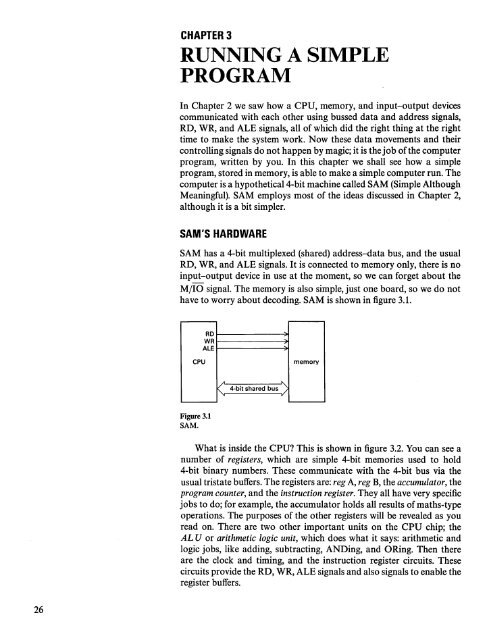Microcomputer Circuits and Processes
Microcomputer Circuits and Processes
Microcomputer Circuits and Processes
Create successful ePaper yourself
Turn your PDF publications into a flip-book with our unique Google optimized e-Paper software.
CHAPTER 3<br />
RUNNING A SIMPLE<br />
PROGRAM<br />
In Chapter 2 we saW how a CPU, memory, <strong>and</strong> input-output devices<br />
communicated with each other using bussed data <strong>and</strong> address signals,<br />
RD, WR, <strong>and</strong> ALE signals, all of which did the right thing at the right<br />
time to make the system work. Now these data movements <strong>and</strong> their<br />
controlling signals do not happen by magic; it is the job of the computer<br />
program, written by you. In this chapter we shall see how a simple<br />
program, stored in memory, is able to make a simple computer run. The<br />
computer is a hypothetical4-bit machine called SAM (Simple Although<br />
Meaningful). SAM employs most of the ideas discussed in Chapter 2,<br />
although it is a bit simpler.<br />
SAM'S<br />
HARDWARE<br />
SAM has a 4-bit multiplexed (shared) address-data bus, <strong>and</strong> the usual<br />
RD, WR, <strong>and</strong> ALE signals. It is connected to memory only, there is no<br />
input-output device in use at the moment, so we can forget about the<br />
MilO signal. The memory is also simple, just one board, so we do not<br />
have to worry about decoding. SAM is shown in figure 3.1.<br />
RD<br />
WR<br />
ALE<br />
CPU<br />
,<br />
memory<br />
K<br />
"<br />
"<br />
4-bit shared bus )<br />
v<br />
Figure 3.1<br />
SAM.<br />
What is inside the CPU? This is shown in figure 3.2. You can see a<br />
number of registers, which are simple 4-bit memories used to hold<br />
4-bit binary numbers. These communicate with the 4-bit bus via the<br />
usual tristate buffers. The registers are: reg A, reg B, the accumulator, the<br />
program counter, <strong>and</strong> the instruction register. They all have very specific<br />
jobs to do; for example, the accumulator holds all results of maths-type<br />
operations. The purposes of the other registers will be revealed as you<br />
read on. There are two other important units on the CPU chip; the<br />
AL U or arithmetic logic unit, which does what it says: arithmetic <strong>and</strong><br />
logic jobs, like adding, subtracting, ANDing, <strong>and</strong> ORing. Then there<br />
are the clock <strong>and</strong> timing, <strong>and</strong> the instruction register circuits. These<br />
circuits provide the RD, WR, ALE signals <strong>and</strong> also signals to enable the<br />
register buffers.<br />
26











